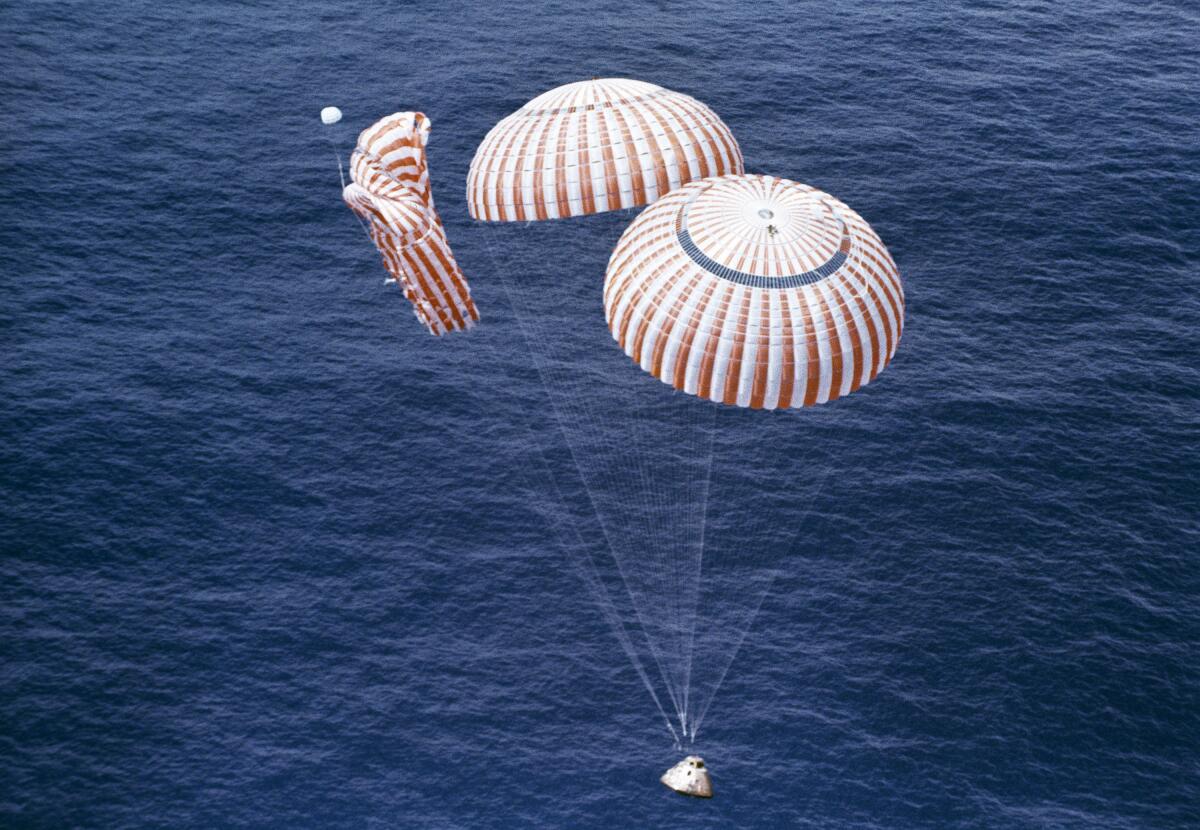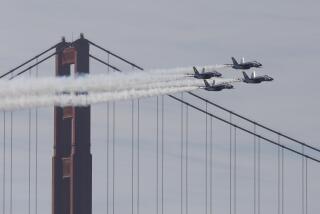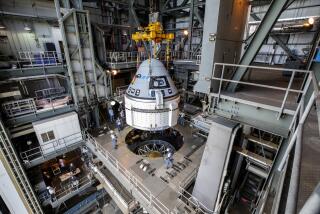Building a rocket is hard. But building a parachute is boggling

SpaceX has a start-up mentality, high ambitions and a slew of accomplishments, which include landing two rocket boosters side by side in a synchronized aerial ballet.
Boeing Co. is a powerful aerospace stalwart whose expertise spans from commercial and military planes to satellites and outside-the-box thinking: Its experimental, reusable space plane, for example, broke records by staying in orbit for more than two years at a time.
But both companies are getting tripped up on parachutes.
It’s a delicate dance to open up parachutes attached to a spacecraft that’s hurtling through the atmosphere at supersonic speeds. The Rube Goldberg-esque sequence involves explosives, precise timing and battles against pressure and high winds. If done right, the astronauts will touch down safely. If not, the crew can be killed on impact.
The technology has improved since the Renaissance-era sketches by Leonardo da Vinci — and especially since the 1950s, when the U.S. military used parachutes in the ballistic missile program. But advances are tricky, and they require extensive physical testing because it’s impossible to build computer models that predict exactly how parachutes will behave.
As SpaceX and Boeing work under NASA contracts to develop spacecraft to ferry astronauts to and from the International Space Station, they keep grappling with this tech.
In April, three of the four parachutes in a SpaceX test failed, crashing their payload into the ground. Last month, during a Boeing test, one of three chutes failed to deploy. That spacecraft managed to land safely anyway. Both companies also face the question of how much to reinforce parachute strings to ensure they can bear enough weight — an upgrade that even NASA hadn’t realized would be needed. And both are working with Airborne Systems, a longtime parachute maker with a Santa Ana factory, on design and production.
The world is about to see Boeing’s parachute system put to the test.
Early Friday, the company plans to launch its Starliner capsule on its first ever uncrewed flight to the space station. After testing the capsule’s ability to attach itself to the space station, the mission is scheduled to conclude Dec. 28 with a landing at White Sands Missile Range in New Mexico that will showcase the parachute system’s effectiveness.
The flight test will be a “phenomenal opportunity” to learn how the systems will perform in real life, Phil McAlister, director of commercial spaceflight development at NASA, told reporters last week. “Computer models are great, but they only go so far.”
The idea of a parachute dates back more than 500 years. One of Da Vinci’s notebooks describes a pyramid with a skeleton of wooden poles and a linen skin that could protect someone jumping from a great height. In 2000, British skydiver Adrian Nicholas tried out that design and successfully floated down 7,000 feet from a hot air balloon using a parachute built from Da Vinci’s 1485 schematic. (After five minutes, he cut himself free from the 187-pound parachute and finished the jump with a conventional one.)
Parachutes for spacecraft are more aerodynamic.
Project Mercury, which put the first U.S. astronaut in space in 1961, based its parachute on those used in the ballistic missile program. Its successor, Project Gemini, experimented a little more, building paragliders or parasails that were eventually abandoned in favor of the more stable parachute.
The Apollo capsule, designed for moon missions, introduced an even harder challenge.
The capsule was initially supposed to be fairly lightweight, but modifications after the fatal Apollo 1 fire increased its heft and changed the parachute calculations. Rather than the single nylon chute used in the Mercury and Gemini capsules, NASA used a total of nine on the heavier Apollo capsule.
“One of the important things when it comes to the Apollo era is safety and redundancy,” said Teasel Muir-Harmony, curator of the Apollo collection at the Smithsonian National Air and Space Museum. “They built a system that could function even if one of the main parachutes failed.”
The first parachute helped jettison the capsule’s heat shield. Next, two parachutes were fired out of a mortar like a bullet out of a gun to slow and stabilize the craft. Once the capsule got down to 11,000 feet, these two disconnected. Three small parachutes were then shot out of a mortar and pulled out the three main parachutes, which slowed the capsule to 22 mph — a safe speed to splash down into the ocean.
Parachutes were so precious to the Apollo program that only three people in the nation were qualified to hand-pack the parachutes for the Apollo 15 capsule: Norma Cretal, Jimmy Calunga and Buzz Corey, who in 1971 — the year of that mission — all lived in Ventura County. Their expertise was so vital, they were not allowed to ride in the same car together for fear that a single auto accident could cripple the space program.
Before launch, the Apollo engineers conducted dozens of drop tests on the parachutes. That gave them confidence in the system.
“When we started recovering manned spacecraft, we totally expected it to be successful,” said Chuck Lowry, an engineering manager in charge of parachute design and other systems in the Apollo program who is now a parachute consultant. “We didn’t jump up and down in joy and say, ‘Wow, it worked!’”
Even so, one of Apollo 15’s three main parachutes did not inflate. The other two were enough to land it safely.
Like then, today’s parachute science is empirical, meaning computer modeling can’t capture all the complexities.
Parachutes encounter turbulent and dynamic airflow, which is almost impossible to replicate with computers, said Erik Seedhouse, an assistant professor in spaceflight operations at Embry-Riddle Aeronautical University. Wind speeds vary at different altitudes. Atmospheric pressure changes in a hundredth of a second. The stresses on a parachute whose job is pulling out a larger parachute can be unpredictable.
“You’d think with all the computing power we have now, we’d be able to model it,” Seedhouse said. “But we can’t.”
Lowry compared parachute movement to a flag in the wind: There’s so much variety, and parachutes’ behavior doesn’t follow strict formulas.
“The models help,” said Patricia Sanders, chairwoman of NASA’s aerospace safety advisory panel. “But you need a lot of data to confirm that your models are capturing the behavior.”
The only way to get a handle on all the possibilities is to go out and test. That’s how SpaceX learned in April that NASA underestimated how much weight certain parachute strings might need to bear. The discovery has repercussions for Boeing’s parachute systems too, according to a November report from NASA’s office of inspector general.
To resolve the issue for itself, SpaceX made its parachute strings more robust, but had to use thinner material for the parachutes to offset the added weight, company President Gwynne Shotwell told reporters this month. The company’s upgraded parachutes have successfully completed 13 tests out of 15.
“You always learn,” she said. “That’s why we test as much as we do.”
Boeing is working with NASA to better understand the situation, but believes it will need to make only minor changes to meet any new requirements, company spokesman Josh Barrett said. The company is confident in its parachutes, he said, and testing has shown that they will work in emergency situations. The company has successfully completed eight tests and has three more scheduled. (Success doesn’t necessarily mean perfection; rather, it means meeting stated objectives.)
Even successful tests can reveal mistakes. The one parachute that did not work during Boeing’s test last month failed to deploy because a pin was not connected, the company determined — a mistake that wasn’t caught during a visual inspection. In future launches, a worker will physically touch the pin to make sure it’s connected, Barrett said.
“This is an extremely important system that has to work in order for the crew to come back to Earth safely,” he said. “We take the design and development and test of it extremely seriously.”
More to Read
Inside the business of entertainment
The Wide Shot brings you news, analysis and insights on everything from streaming wars to production — and what it all means for the future.
You may occasionally receive promotional content from the Los Angeles Times.











